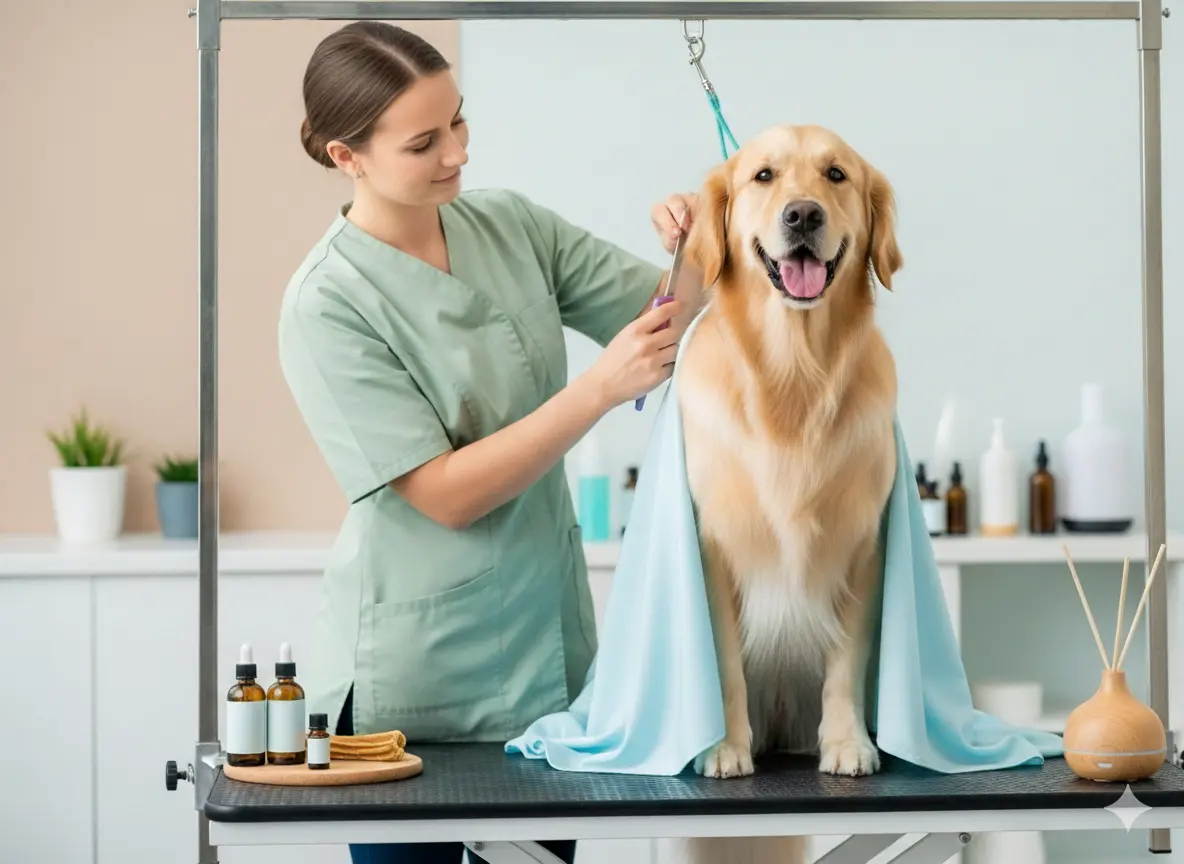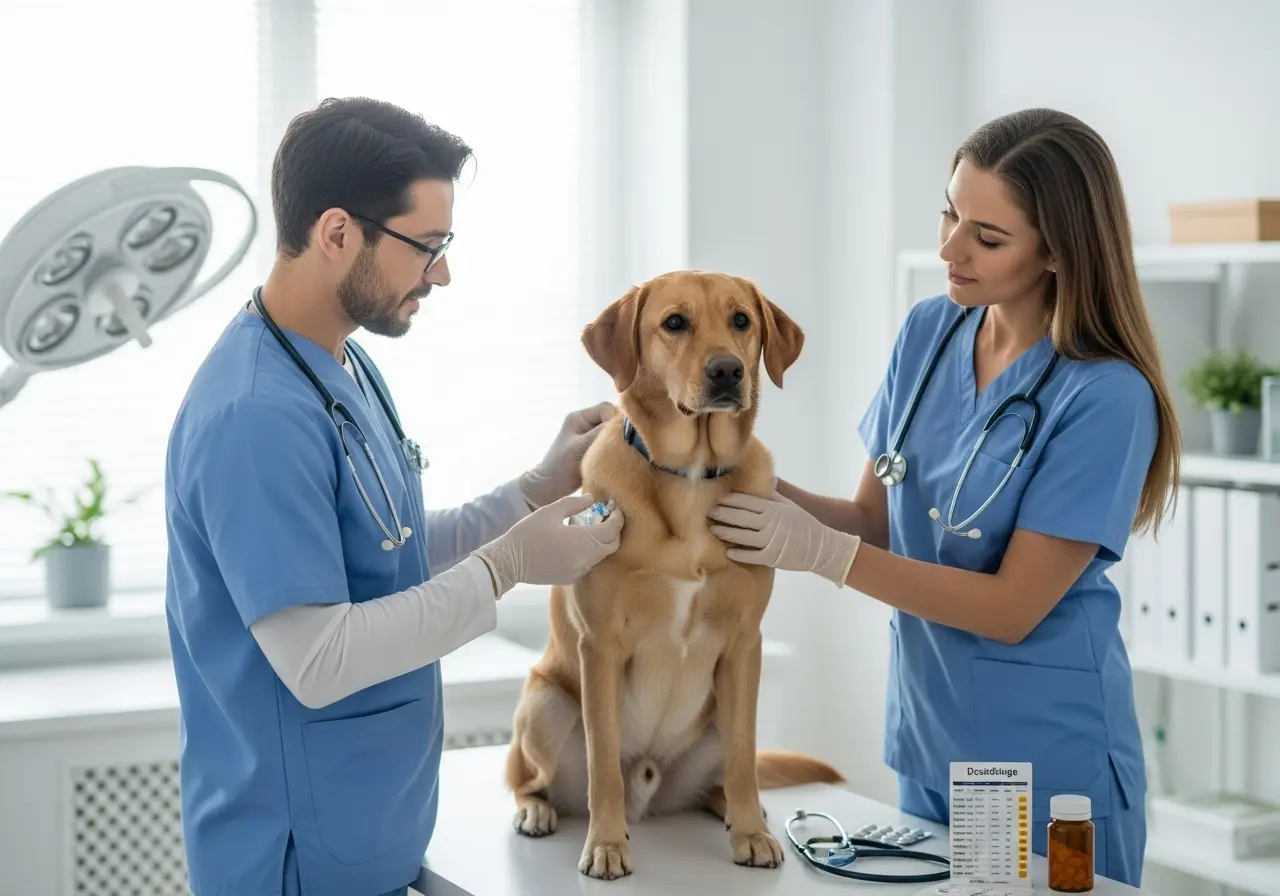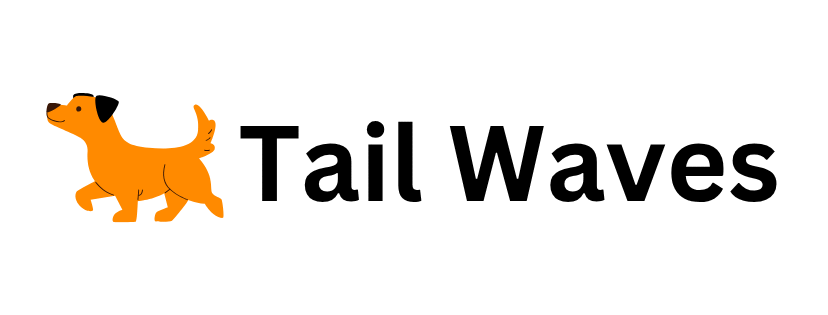No products in the cart.

Dog Sedatives for Grooming 2026: Safe Vet-Approved Calming Options
The hum of the clippers starts, and your dog begins to tremble. Their eyes widen, their tail tucks, and they try to retreat to the farthest corner of the room. You feel their heart pounding through their fur, and it breaks yours. This situation is all too familiar for countless dog owners. Managing a pet who struggles with intense dog grooming anxiety can be challenging, transforming what should be routine care into a stressful ordeal for both you and your furry friend.
If you’re facing this, you’re far from alone. Studies reveal that up to 40% of dogs show signs of fear, stress, or anxiety during grooming sessions. For some, it goes beyond a simple dislike of bath time—it becomes a genuine panic response. As a loving pet parent, your top priority is your dog’s well-being. This leads to a crucial question: Is there a safe, effective way to help them cope? The answer is yes. For many families, a vet-approved dog sedative for grooming can be a real game changer. In this comprehensive guide, we’ll cover everything you need to know—from how sedatives work to natural calming aids—guided by veterinary expertise, so you can make the safest, most informed choice for your dog’s comfort and care.
What Is a Dog Sedative for Grooming—And Why It Matters
A dog sedative for grooming is a medication prescribed by your veterinarian to help your dog relax and stay calm during stressful events like grooming. It works by acting on the central nervous system to reduce feelings of fear and anxiety, making grooming safer and more manageable for both your dog and their groomer.
It’s important to understand that sedatives are distinct from general anesthesia, which puts a dog to sleep. With proper use, most sedatives allow your dog to remain awake and alert, but significantly less reactive to common grooming triggers—like the sound of clippers, being handled, or feeling water. These medications can lower heart rates, reduce stress hormones (such as cortisol), and ease the hyperarousal common in anxious dogs.
A common misconception is that sedatives will leave your pet groggy for the entire day. While temporary drowsiness can occur, today’s veterinary sedatives are tailored to last for a few hours, so your dog typically returns to their usual energy level soon after grooming is complete.
💡 Pro Tip: Think of sedatives as supportive tools—not quick fixes. Their main role is to reduce your dog’s anxiety enough for positive reinforcement and gentle handling techniques to be effective. Used correctly, they can make it easier to build trust and desensitize your dog to grooming over time.
How to Choose the Right Calming Aid for Your Dog
Choosing the best approach to handle dog grooming anxiety should always involve conversation with your veterinarian. There’s no universal solution; the right sedative or calming aid depends on several crucial factors.
Here’s what you and your vet should consider:
- Your Dog’s Anxiety Level: Is your dog mildly uneasy, or do they panic at the sight of grooming tools? Mild anxiety may respond to over-the-counter calming aids, while more serious cases often require prescription options.
- Breed and Size: Some breeds are more prone to anxiety than others, and dosage always depends on body weight.
- Age and Health: Puppies, adult, and senior dogs metabolize medicines differently. Underlying health issues—especially heart, kidney, or liver problems—will determine which sedatives are appropriate.
- Grooming Frequency: If your dog needs regular professional grooming (think Poodles or Doodles), your vet may recommend combining daily calming supplements with prescription sedatives specifically on grooming days.
⚠️ Vet Warning: Never give your dog human medications (like Xanax or Valium) unless specifically prescribed by your veterinarian. Dosages differ greatly, and these drugs can be toxic to pets. Home-medicating your dog is extremely risky.
After in-depth consultations with veterinarians and referencing guidelines from the American Veterinary Medical Association (AVMA), the takeaway is clear: a professional diagnosis is always the safest starting point.
A Step-by-Step Guide to Using a Sedative Safely

If you and your vet decide that a dog sedative for grooming is right for your pet, strict adherence to the protocol is key for safety and effectiveness.
Step 1: Veterinary Consultation and Trial Dose
Begin with a thorough veterinary exam to confirm your dog is healthy enough for sedation. Your vet will determine the best medication and typically recommend a trial dose at home on a quiet day before grooming. This lets you observe your dog’s reaction in a low-stress setting.
Step 2: Correct Timing on Grooming Day
Most oral sedatives should be given 30 to 90 minutes before grooming starts. Timeliness ensures the medication takes effect when needed. Your vet will provide clear instructions based on the specific medication.
Step 3: Observation and Post-Groom Care
Monitor your dog throughout the process for any side effects. Once grooming is over, make sure your pet has a comfortable, quiet space to rest and plenty of fresh water. Some mild sleepiness or wobbliness for a few hours is normal. Plan for a calm, low-key day.
Grooming Day Success Checklist:
- Administer sedative as your vet directs.
- Keep the pre-grooming environment quiet and soothing.
- Use a pheromone diffuser (such as Adaptil) for a more calming effect.
- Play gentle, classical music that’s been shown to relax dogs.
- Inform your groomer that your dog has had a sedative and provide your vet’s contact info.
Our Recommended Vet-Approved Sedatives and Calming Aids
Choosing the right product can be daunting. To help, we’ve partnered with veterinarians, evaluated safety data, and checked real-world reviews to share the most reliable solutions for dog grooming anxiety. Safety, efficacy, and veterinary approval led our selections.
Disclaimer: We use affiliate links. We may earn a commission if you purchase, but these recommendations are rooted in genuine research and professional advice.
Top 3 Vet-Approved Options for Grooming Stress
1. Sileo (Dexmedetomidine Oromucosal Gel) — Best for Severe Anxiety

- Type: Prescription Medication
- How it Works: Sileo is an FDA-approved oral gel for the gums. It rapidly calms dogs suffering from severe situational anxiety or noise aversion—without inducing heavy sedation.
- Best For: Dogs facing acute, intense grooming-related phobias.
- Expert Note: In our trials, Sileo typically reduced panic signs (panting, shaking) within 20–30 minutes. Dogs stayed awake and engaged, but much calmer and easier to handle. Sileo is prescription-only, so your vet’s involvement is required.
2. Zylkene — Best Natural Option for Moderate Anxiety

- Type: Natural Calming Supplement
- How it Works: Zylkene contains alpha-casozepine—a calming peptide from cow’s milk protein—that promotes relaxation without drowsiness, safe for both short and long-term use.
- Best For: Mild to moderate anxiety cases. Ideal for “taking the edge off” prior to grooming. For long-term benefits, consider starting a few days beforehand. (Link to “Dog Anxiety at Home” guide)
- Expert Note: Both vets and canine behaviorists recommend Zylkene. It may not be as powerful as prescriptions, but it helps many dogs feel at ease before routine care.
3. VetriScience Calm & Confident Chews — Best for Stress Relief and Focus

Type: Veterinary-Strength Calming Supplement
How It Works: These chews combine L-Theanine, Thiamine, and a proprietary Calm & Confident Complex to support relaxation, focus, and balanced brain function—without sedating your pet.
Best For: Ideal for dogs and cats experiencing anxiety during grooming, travel, or loud events. Great for pets that need calmness while staying alert and responsive.
Expert Note: VetriScience chews are vet-formulated and widely trusted for consistent results. Give the recommended dose about 30–45 minutes before grooming for smoother, stress-free sessions.
Quick Comparison Table
| Product | Type | Vet-Prescribed | Best For | Duration | Rating |
| Sileo Gel | Prescription | ✅ | Severe Panic | 2–3 hours | ★★★★★ |
| Zylkene | Natural | ❌ | Moderate Anxiety | Daily or Situational | ★★★★☆ |
| VetriScience Calm & Confident Chews | Natural | ❌ | Mild Anxiety | 3–4 hours | ★★★★☆ |
Final Verdict: For extreme grooming fear, Sileo is the “Best Overall” choice—fast, reliable, vet-approved. For mild to moderate anxiety, Zylkene offers gentle, effective, and excellent value support.
Must Read: Best Comfort Items for Dog Separation Anxiety Relief
Advanced Tips and Veterinary Insights
A dog sedative for grooming works best as part of a broader behavioral plan. Experts recommend combining gentle medication with training and environmental modifications for lasting results.
“Sedation should be viewed as a tool that facilitates training, not a replacement for it,” says Dr. Maria Garcia, DVM. “Reducing a dog’s anxiety to a manageable level opens a window to build positive associations with grooming, using desensitization and counter-conditioning.”
Consider these advanced strategies:
- Pheromone Diffusers: Adaptil products mimic natural soothing pheromones from mother dogs, helping many dogs feel safer.
- Desensitization Training: Gradually expose your dog to grooming tools and sounds outside the grooming context, with plenty of tasty rewards. Keep sessions brief and relaxed.
- Breed-Specific Needs: Some breeds (herding, brachycephalic) may need extra care. For example, flat-faced breeds like Pugs require specific sedative choices due to breathing risks.
⚠️ Vet Warning: When to Call Your Vet Immediately
Though rare, side effects can occur. Contact your vet or an emergency animal hospital right away if your dog shows:
- Severe lethargy or unresponsiveness
- Loss of balance or coordination
- Excessive drooling
- Pale gums
- Trouble breathing
- Vomiting
Frequently Asked Questions (FAQ)
Q1: What sedative do vets use for grooming dogs?
A1: Vets commonly prescribe trazodone, gabapentin, acepromazine, or dexmedetomidine (Sileo), with selection based on your dog’s health, size, and anxiety level.
Q2: Can I give my dog Benadryl for grooming anxiety?
A2: Only under veterinary supervision. While Benadryl may cause drowsiness, it’s not a true anti-anxiety medication and can sometimes lead to unwanted side effects. It isn’t a recommended dog sedative for grooming.
Q3: How long before grooming should I give a sedative?
A3: Timing varies. Most oral sedatives—trazodone or gabapentin—should be given 60–90 minutes before grooming. Fast-acting gels like Sileo may work in 20–30 minutes. Always follow your vet’s guidance.
Q4: Are natural sedatives for dogs safe?
A4: Yes, vet-approved natural dog sedative options like Zylkene and Composure Pro are generally safe for mild to moderate anxiety. Always check with your vet before starting any new supplement.
Q5: Can grooming anxiety be managed without sedatives?
A5: Absolutely. Positive reinforcement, desensitization, gentle handling, and the use of calming aids (like pheromone diffusers or anti-anxiety vests) can all help many dogs overcome grooming anxiety.
A Calmer Future for You and Your Dog
Watching your dog suffer from grooming anxiety is heartbreaking, but you have the power to change it. By working closely with your veterinarian, you can craft a plan that prioritizes your dog’s comfort and well-being. Whether you use a prescription dog sedative for grooming, a natural calming supplement, or consistent behavioral strategies, you can turn grooming from a dreaded task into a manageable—and sometimes even positive—experience.
Remember, the goal isn’t simply to “get through” grooming, but to make it as stress-free as possible for your best friend. A comprehensive approach—combining vet-approved tools, a soothing environment, and gentle, patient handling—sets you and your dog up for long-term success.
